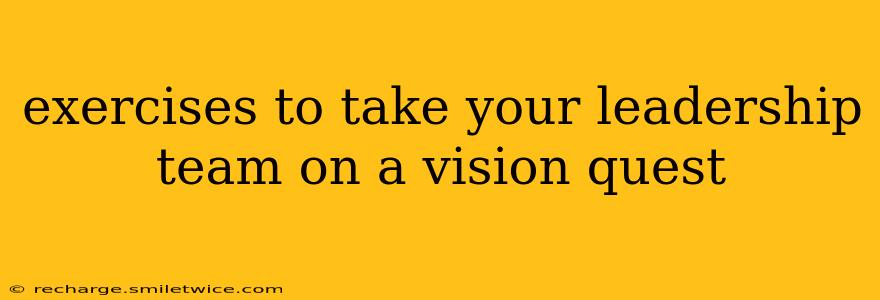Transforming your leadership team into a unified, forward-thinking force requires more than just meetings and presentations. A vision quest, though metaphorical in a corporate setting, can foster crucial team bonding, strategic alignment, and a shared understanding of the future. This isn't about literal wilderness treks; instead, it's about using structured exercises to unlock collective vision and inspire action. This article explores several proven exercises to guide your leadership team on a powerful, transformative vision quest.
What is a Vision Quest for a Leadership Team?
A leadership team vision quest is a carefully designed process aimed at fostering a shared understanding of the organization's future. It's about collaboratively defining a compelling vision, identifying the path to achieve it, and aligning the entire team behind a common goal. Unlike traditional planning sessions, a vision quest emphasizes introspection, creativity, and collaborative storytelling to cultivate a deeper emotional connection to the shared vision.
Exercises to Ignite Your Leadership Team's Vision
Here are several exercises suitable for a leadership team vision quest, designed to encourage collaboration, introspection, and strategic thinking:
1. Future Self Storytelling: What will success look like?
This exercise encourages individual reflection before collaborative brainstorming. Each team member spends time visualizing the organization's ideal future state – 5, 10, even 20 years down the line. They then write a short story describing what that future looks like, focusing on tangible achievements, team dynamics, and the organization's impact on the world. Sharing these stories aloud fosters empathy and reveals individual aspirations within the larger organizational context.
2. The Ideal Day Exercise: A glimpse into a thriving future.
Ask your team to imagine their ideal workday in the future, once the organization's vision has been fully realized. What are they doing? Who are they working with? What challenges are they overcoming? This exercise reveals the tangible aspects of the envisioned future, grounding the abstract vision in concrete realities and making it more relatable.
3. Collaborative Vision Board: Visualizing the path forward.
A visual representation can be incredibly powerful. Provide your team with a large canvas, sticky notes, markers, and magazines. Collectively, they can create a vision board representing their shared aspirations. Images, words, and symbols can all contribute to a powerful visual narrative of the organization's future. This exercise encourages participation from all team members and creates a shared artifact symbolizing their collective vision.
4. The "Big Hairy Audacious Goal" (BHAG) Workshop: Defining ambitious targets.
Setting ambitious, almost audacious goals pushes teams to think beyond the status quo. This workshop focuses on defining a BHAG – a goal so significant it stretches the team's capabilities. The process involves brainstorming, prioritizing, and refining the goal until it's both ambitious and achievable through strategic planning and dedicated effort.
5. Scenario Planning: Preparing for various futures.
This exercise helps the team prepare for uncertainties. Develop several potential future scenarios, ranging from optimistic to pessimistic. By considering these possibilities, the team can identify potential risks and opportunities and formulate contingency plans, strengthening their resilience and adaptability.
6. "Strengths, Weaknesses, Opportunities, Threats" (SWOT) Analysis: Identifying key factors.
A classic strategic planning tool, SWOT analysis helps identify the organization's internal strengths and weaknesses, as well as external opportunities and threats. Using this framework, the team can analyze their current position and identify areas for improvement and strategic advantage, ensuring the vision is realistic and achievable.
How to Facilitate a Vision Quest Successfully
Remember, the success of a vision quest depends heavily on effective facilitation. Consider these key elements:
- Create a Safe Space: Encourage open communication and vulnerability.
- Active Listening: Ensure everyone feels heard and valued.
- Clear Objectives: Establish clear goals for the session.
- Structured Activities: Use the exercises as a guide, but be adaptable.
- Action Planning: Translate the vision into concrete steps and assign responsibilities.
By incorporating these exercises and focusing on creating a supportive and collaborative environment, you can guide your leadership team on a powerful vision quest that will unite them, inspire them, and propel your organization toward a brighter future.
